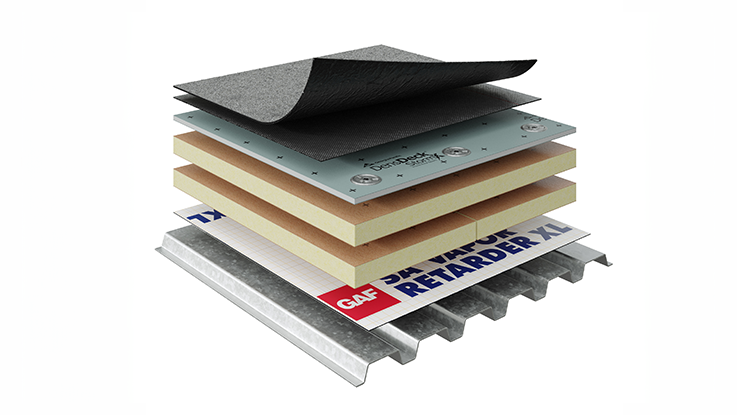

Asphalt roofing solutions
What are asphalt roofing solutions and why are they trusted roofing solutions?
Asphalt is one of the oldest roofing technologies still in use today and it is a reliable solution for both residential and commercial roofing needs. Asphalt roofing uses asphalt as a waterproofing membrane.
Commercial asphalt roofing systems consist of two or more waterproofing layers. This redundancy provides building owners with durable waterproofing protection.
Asphaltic roofing installation methods

Hot-Mopped

Heat-Welded/Torch-Applied

Cold-Applied

Self-Adhered

GAF Roofing | How to Install the 3 Component M-Curb System

GAF Roofing | Torch Applied Training for Inside Corner

GAF Roofing | How to install a Pre-Flashed M-Weld Drain Insert
Asphaltic roofing systems


SBS (Styrene Butadiene Styrene)

APP (Atactic Polypropylene)

EnergyCap™

Comparing asphaltic roofing techniques
1 See the applicable manual for installation temperature instructions and ranges at https://www.gaf.com/document-library.
2 GAF warranties and guarantees do not cover leaks or other damage due to wind speeds in excess of 55 miles per hour (unless additional wind coverage is purchased on eligible jobs). Refer to gaf.com for more information on warranty and guarantee coverage and restrictions.
3 GAF warranties and guarantees do not provide coverage against punctures (unless additional puncture resistance coverage is purchased on eligible jobs). Refer to gaf.com for more information on warranty and guarantee coverage and restrictions.
4 Require the use of RUBEROID® "EnergyCap™" Products.
5 See the applicable manual for installation at https://www.gaf.com/document-library. See applicable warranty or guarantee for complete coverage restrictions.
Where and when to use the different types of asphalt roofs
Roofs of essential buildings that need to stay open and operational at all times.
BUR is a solution that has been used for over 100 years. The redundant applications allow for increased protection against damage and leaks.
Roofs that need the reliability of a redundant asphaltic system without the odor and labor required for hot mopping. APP sheets are also used to recover existing roof systems.
APP is often used in smaller commercial roofing jobs, especially in urban areas. APP sheets are torched on to the surface below, therefore there is no need for a kettle, buckets or the inconvenience of getting asphalt onto the roof. In addition, APP systems typically consist of fewer plies than BUR jobs, allowing them to be installed faster and with a smaller labor force. Switching from a hot mopped application to a torch application will also reduce the odor around the work location allowing for more comfortable conditions for the workers and building occupants. A CERTA (Certified Roofing Torch Applicator) certification is required for a roofer to use a torch.
APP membranes are classified by ASTM numbers, types and grades.
ASTM D6222 – APP sheet using polyester reinforcement
ASTM D6223 – APP sheet using both polyester and glass fiber reinforcement
ASTM D6222 and D6223 have two type classifications, Type I and Type II. Typically Type II will have a larger mass and higher physical properties than Type I. There are two grades of APP sheet:
Grade S: the sheet has a smooth surface
Grade G: the sheet has a granule surface
ASTM number, type and grade are specified by the architect in most cases.
For roofs requiring the reliability of asphalt with more flexible application methods and labor availability. Introduced in the 1970’s, SBS features asphalt that has been modified (thus called modified bitumen) with the polymeric material SBS.
Like APP, SBS can also be applied utilizing a torch (heat-welding). A CERTA (Certified Roofing Torch Applicator) certification is required for a roofer to use a torch. Many local ordinances also restrict the use of torches on roofs due to their risk as a potential fire hazard. Unlike APP, SBS can be applied in a variety of other ways including hot-mopped, cold-applied or self-adhered. Cold-applied applications are popular because they don't produce as much odor as hot-mopped and do not require professional certifications like torching. Self-adhered is also a popular method because there is virtually no odor and it is typically faster to install.
SBS membranes are classified by ASTM numbers, types and grades:
ASTM D6162: SBS sheet using a combination of both polyester and glass fiber
ASTM D6163: SBS sheet using glass fiber reinforcement
ASTM D6164: SBS sheet using polyester reinforcement
ASTM D6162 and D6163 have three type classifications, Type I, Type II and Type III.
ASTM D6164 has two type classifications, Type 1 and Type 2. Typically, the higher the type, the larger the mass and physical properties.
There are two grades of SBS sheet:
Grade S: The sheet has a smooth surface
Grade G: The sheet has a granule surface
ASTM number, type and grade are specified by the architect in most cases.
For buildings that require ENERGY Star® certification or to be LEED® certified.
Utilize an EnergyCap™ sheet with any BUR, APP, and SBS system for projects that require the reliability of asphalt roofing and Energy Star® and LEED® certified solutions.
Tested in the field for decades, GAF asphaltic roofing materials provide durability and performance
Time-tested
Meets third party standards
Reliable manufacturer
Commitment to quality
